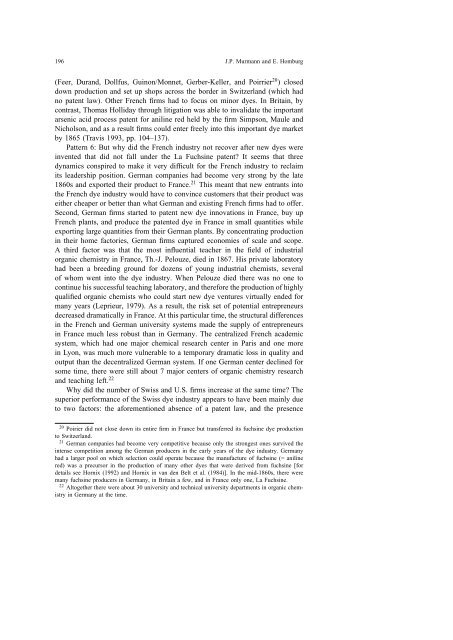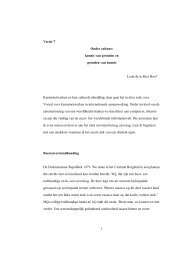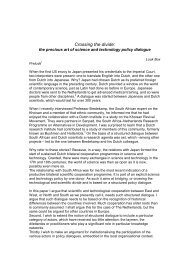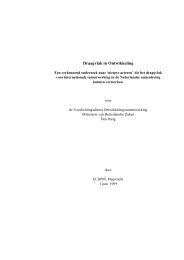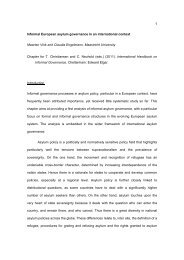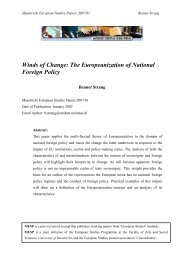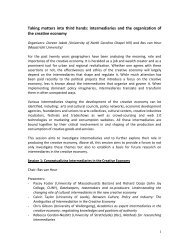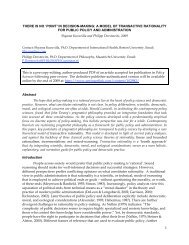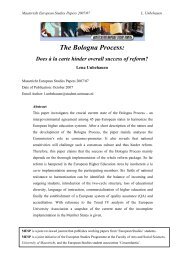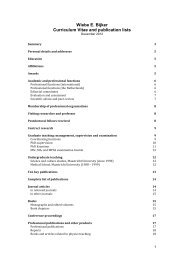the case of the synthetic dye industry, 1857–1914 - Maastricht ...
the case of the synthetic dye industry, 1857–1914 - Maastricht ...
the case of the synthetic dye industry, 1857–1914 - Maastricht ...
You also want an ePaper? Increase the reach of your titles
YUMPU automatically turns print PDFs into web optimized ePapers that Google loves.
196 J.P. Murmann and E. Homburg<br />
(Feer, Durand, Dollfus, Guinon/Monnet, Gerber-Keller, and Poirrier 20 ) closed<br />
down production and set up shops across <strong>the</strong> border in Switzerland (which had<br />
no patent law). O<strong>the</strong>r French firms had to focus on minor <strong>dye</strong>s. In Britain, by<br />
contrast, Thomas Holliday through litigation was able to invalidate <strong>the</strong> important<br />
arsenic acid process patent for aniline red held by <strong>the</strong> firm Simpson, Maule and<br />
Nicholson, and as a result firms could enter freely into this important <strong>dye</strong> market<br />
by 1865 (Travis 1993, pp. 104–137).<br />
Pattern 6: But why did <strong>the</strong> French <strong>industry</strong> not recover after new <strong>dye</strong>s were<br />
invented that did not fall under <strong>the</strong> La Fuchsine patent? It seems that three<br />
dynamics conspired to make it very difficult for <strong>the</strong> French <strong>industry</strong> to reclaim<br />
its leadership position. German companies had become very strong by <strong>the</strong> late<br />
1860s and exported <strong>the</strong>ir product to France. 21 This meant that new entrants into<br />
<strong>the</strong> French <strong>dye</strong> <strong>industry</strong> would have to convince customers that <strong>the</strong>ir product was<br />
ei<strong>the</strong>r cheaper or better than what German and existing French firms had to <strong>of</strong>fer.<br />
Second, German firms started to patent new <strong>dye</strong> innovations in France, buy up<br />
French plants, and produce <strong>the</strong> patented <strong>dye</strong> in France in small quantities while<br />
exporting large quantities from <strong>the</strong>ir German plants. By concentrating production<br />
in <strong>the</strong>ir home factories, German firms captured economies <strong>of</strong> scale and scope.<br />
A third factor was that <strong>the</strong> most influential teacher in <strong>the</strong> field <strong>of</strong> industrial<br />
organic chemistry in France, Th.-J. Pelouze, died in 1867. His private laboratory<br />
had been a breeding ground for dozens <strong>of</strong> young industrial chemists, several<br />
<strong>of</strong> whom went into <strong>the</strong> <strong>dye</strong> <strong>industry</strong>. When Pelouze died <strong>the</strong>re was no one to<br />
continue his successful teaching laboratory, and <strong>the</strong>refore <strong>the</strong> production <strong>of</strong> highly<br />
qualified organic chemists who could start new <strong>dye</strong> ventures virtually ended for<br />
many years (Leprieur, 1979). As a result, <strong>the</strong> risk set <strong>of</strong> potential entrepreneurs<br />
decreased dramatically in France. At this particular time, <strong>the</strong> structural differences<br />
in <strong>the</strong> French and German university systems made <strong>the</strong> supply <strong>of</strong> entrepreneurs<br />
in France much less robust than in Germany. The centralized French academic<br />
system, which had one major chemical research center in Paris and one more<br />
in Lyon, was much more vulnerable to a temporary dramatic loss in quality and<br />
output than <strong>the</strong> decentralized German system. If one German center declined for<br />
some time, <strong>the</strong>re were still about 7 major centers <strong>of</strong> organic chemistry research<br />
and teaching left. 22<br />
Why did <strong>the</strong> number <strong>of</strong> Swiss and U.S. firms increase at <strong>the</strong> same time? The<br />
superior performance <strong>of</strong> <strong>the</strong> Swiss <strong>dye</strong> <strong>industry</strong> appears to have been mainly due<br />
to two factors: <strong>the</strong> aforementioned absence <strong>of</strong> a patent law, and <strong>the</strong> presence<br />
20 Poirier did not close down its entire firm in France but transferred its fuchsine <strong>dye</strong> production<br />
to Switzerland.<br />
21 German companies had become very competitive because only <strong>the</strong> strongest ones survived <strong>the</strong><br />
intense competition among <strong>the</strong> German producers in <strong>the</strong> early years <strong>of</strong> <strong>the</strong> <strong>dye</strong> <strong>industry</strong>. Germany<br />
had a larger pool on which selection could operate because <strong>the</strong> manufacture <strong>of</strong> fuchsine (= aniline<br />
red) was a precursor in <strong>the</strong> production <strong>of</strong> many o<strong>the</strong>r <strong>dye</strong>s that were derived from fuchsine [for<br />
details see Hornix (1992) and Hornix in van den Belt et al. (1984)]. In <strong>the</strong> mid-1860s, <strong>the</strong>re were<br />
many fuchsine producers in Germany, in Britain a few, and in France only one, La Fuchsine.<br />
22 Altoge<strong>the</strong>r <strong>the</strong>re were about 30 university and technical university departments in organic chemistry<br />
in Germany at <strong>the</strong> time.


